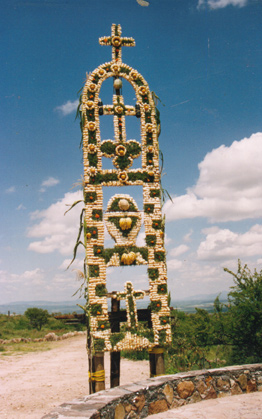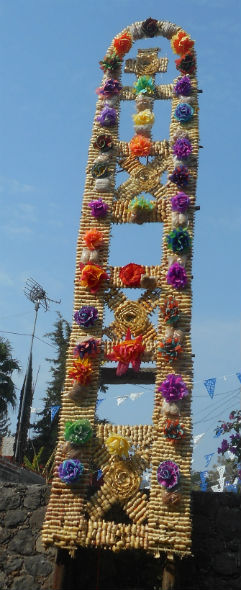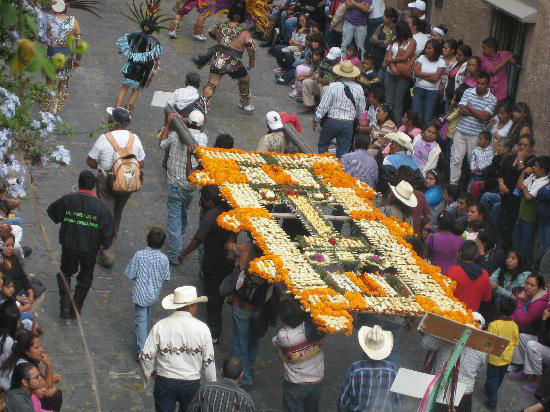
by Joseph Toone
Xuchiles are funeral offerings in the form of flowers and cacti about a meter wide and a storey and half high. They are intricate to the Chichimeca celebrations of the feast day of the town’s namesake, St. Michael the Archangel. The Chichimecas were the indigenous hunter gathers here when the Spanish arrived. So many return to San Miguel from all over Mexico for the feast of St. Michael that local schools are closed to provide sleeping quarters for all the visitors.
The construction of a xuchil requires great skill. First the sticks are tied in a parallel fashion in order to form a rectangle. Upon this skeleton structure of reeds are mounted on each side squares of about ten inches covered with a matting woven of a plant called “little spoon,” because of the shape of its leaves. In each xuchil three of four of these squares are left empty. Within the vacant squares are placed flower arrangements, saints, crosses and other motifs. All the arrangements are made in part of dyed tortillas, sunflowers, marigolds and passion flowers. At the top of each xuchil appears a handsome woven cross.

Alongside the xuchil’s cross are often two smaller crosses. They are not for St. Dimas and Gespas, the lads crucified alongside Jesus. Rather these crosses represent Wolf and Coyote, two fierce Chichimeca warriors from the Battle of the Barbarians fought nearby in 1530. These crosses were prohibited from being in the procession since 1960. The ban was put into effect by a priest not partial to the notion that two men that fought the Catholics were being honored. In recent years, however, I’ve seen Wolf and Coyote creep back into the celebration.
Each group of Chichimeca dancers escorting a xuchil includes men, women and children. They create the sign of the cross with their feet to thank their ancestors for joining the new faith. In the group are persons who made religious vows to make the pilgrimage to town and others who have taught the dancers. Amateurs need not apply, nor are strangers permitted to disturb the dignity, unity and discipline of the group. Costumes are often warlike and highly individualized. They frighten me, a tall present-day man. I can only imagine the reaction from those tiny Spanish folk that arrived so long ago.

Groups are often led by two elders (or younger folks dressed as senior citizens), a man in white cotton trousers and a woman. They represent the ancient gods of astrology and calendars, Cipactonal (him) and Oxomoco (her). They were the first human couple, like a New World version of Adam and Eve.
Interspersed in the procession are the clowns, skeletons and other locos (crazies). Also appearing is the devil, with his ever-present whip to keep participants submissive.

Following a four-hour procession in honor of St. Michael, the xuchiles are placed in front of the Parroquia. This symbolically brings the ancestors back to their tombs, for St. Michael’s church was build atop the Chichimeca graveyard. The Spanish always built churches where the indigenous were already use to worshipping. In much the same way pyramids were dismantled and their stones used at that spot to build a church.
Before leaving town, the dancers have food blessed by priests and brought to the prison. The xuchiles are left behind to silently decay. You can view theirs, and other xuchil remains alongside churches throughout town and in cemeteries following their use in funeral processions.
**************

Joseph Toone is Amazon's bestselling author of the San Miguel de Allende Secrets series of books and TripAdvisor's best rated historical walking tour guide. For more information contact toone.joseph@yahoo.com or visit History and Culture Walking Tours or JosephTooneTours.com, also on FaceBook.
|